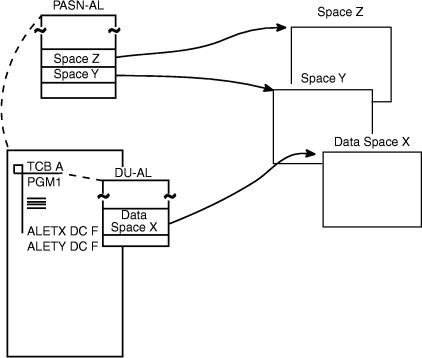An access list can be one of two types:
- A dispatchable unit access list (DU-AL), the access list that is associated with the TCB
- A primary address space access list (PASN-AL), the access list that is associated with the primary address space
Figure 1 shows PGM1 that runs in AS1 under TCB A. The
figure shows TCB A's DU-AL. It is available to PGM1 (and to other
programs that TCB A might represent). The DU-AL has an entry for
Data Space X, and PGM1 has the ALET for Data Space X. Therefore,
PGM1 has access to Data Space X. PGM1 received an ALET for Space Y
from another program. The PASN-AL has the entry for Space Y. Therefore,
PGM1 also has access to Data Space Y. Because it does not have the
ALET for Space Z, PGM1 cannot access data in Space Z.
Figure 1. An
Illustration of a DU-AL

The differences between a DU-AL and a PASN-AL are significant and you need to understand them. The following table summarizes the characteristics of DU-ALs and PASN-ALs as they relate to problem state programs with PSW key 8 - F.
| DU-AL | PASN-AL |
|---|---|
| Each work unit (TCB and SRB) has its own unique DU-AL. All programs associated with that work unit can use its DU-AL. | Each address space has its own unique PASN-AL. All programs that run in the primary address space can use its PASN-AL. |
| A program that the work unit represents can add and delete entries on the work unit's DU-AL for the data spaces it created or owns. | A program can add entries for the data spaces it owns or created to the PASN-AL, providing an entry for the data space is not already on the PASN-AL through the actions of another problem state program with PSW 8 - F. A program can delete entries for data spaces it owns or created. |
| A program cannot pass its task's DU-AL to a program running under another task, with one exception: when a program issues an ATTACH macro, it can pass a copy of its DU-AL to the subtask. This allows the subtask to start with a copy of the attaching task's DU-AL. After the attach, the attaching task and the subtask can add and delete entries on their own DU-ALs. | A PASN-AL cannot be passed from one address space to another. |
| A DU-AL can have up to 509 entries. | A PASN-AL can have up to 510 entries, some of which are reserved for the type of space called SCOPE=COMMON. |
| When the work unit terminates, the DU-AL is purged. | When the owning jobstep task terminates, the PASN-AL is purged. |